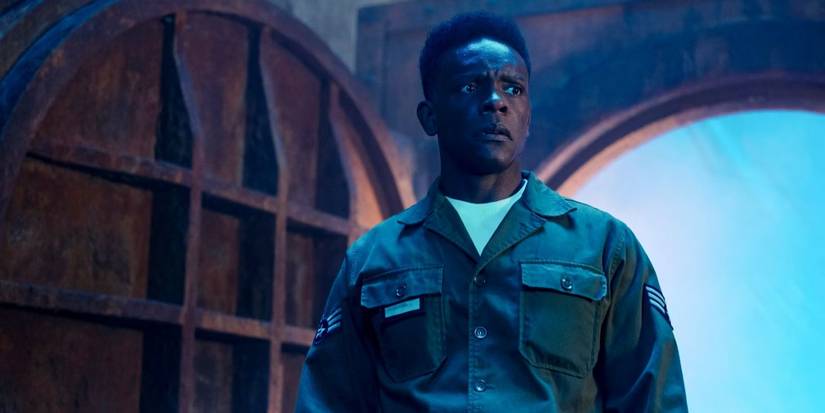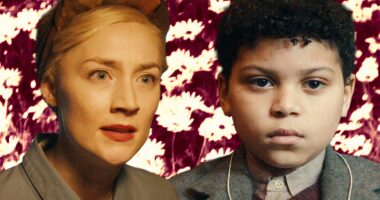[Editor’s note: The following contains spoilers for IT: Welcome to Derry.]
The HBO series IT: Welcome to Derry dives deeper into the world Stephen King created while exploring the origins of the entity that permeates through the quaint town. Set in 1962, at the time of the Cold War when the fears of nuclear attack and radiation were at the forefront, there are enough scares, unexpected deaths, surprising twists and Easter eggs to make you realize that no one is safe. And while it’s clear that Rose (Kimberly Guerrero) knows that bad things happen in Derry and that a new cycle of evil has been set in motion, General Shaw (James Remar) is keeping his men in the dark about his plan for the entity.
During this interview with Collider, showrunners Jason Fuchs and Brad Caleb Kane discussed the risks that come with tackling the work of King, telling a story that’s as timely today as it was when it was originally written, the anthological component to their approach for each season, deciding what to reveal about the entity, the development of the sequence in the car in the first episode, devising how the movie theater massacre would play out, and figuring out who this Dick Hallorann (Chris Chalk) would be.
‘IT: Welcome to Derry’ Is an Exploration of the Weaponization of Fear
“This is a story about how IT uses fear against the people of Derry.”
Collider: What is the biggest intimidation factor when it comes to taking on a Stephen King story and world? Specifically with this story, was there anything you wanted to make sure you really delivered on, in order to be true to the story, the characters, and the world?
JASON FUCHS: There are risks abound when you’re doing something like that. We’re both mega Stephen King fans. We’re huge fans of the book. Both of us read the book at an inappropriately young age. You want to do right by the fan base, of which we count ourselves among it. You want to do right by Stephen King. You want him to feel like this is an organic and authentic extrapolate of his work. Obviously, we love the IT films. I was lucky enough to work on the second one, and you want to live up to the extraordinary cinematic, high watermark that the Muschiettis set with those. So, there are risks abound, but also tremendous opportunity and reward if you nail it, and that’s what we tried to do.
We were committed, from very early on, to telling a story that felt like it was true to the core themes we cared about in the book and that certainly resonated with us as readers, as viewers, and as fans, most specifically, the weaponization of fear. This is a story about how IT uses fear against the people of Derry. IT uses fear as a tool to turn people against one another and to make characters think they’re alone in their struggle. Watching characters grapple with that felt like it would be an authentic extension of a book and a story we loved, and also a story that is as timely today as when Stephen King first wrote it.
BRAD CALEB KANE: The other thing that was sort of intimidating in tackling this was that we know IT’s cycles are every 27 years. The movie takes place in 1989, so that left 1962 as the earlier cycle. The fears of 1962 were very different from 1989, when the Red Scare was ending. In 1962, it’s very much alive. There were fears of nuclear war. A lot of people look at 1962 as the last Age of Innocence in America, but obviously that is a facade. It was not an innocent time for most people, or many people – a large section of society in America in 1962. So, we knew we had to tackle the legitimate and genuine fears of that time also. As you can imagine, that was intimidating, considering what those fears were.
Because you are telling the story in cycles, will this season fully conclude that story of 1962? Do you have to finish that story because the next season will be in another era?
FUCHS: Yes and no. There is an anthological component to this show where we are telling a complete story of a given cycle in IT’s reign of terror in Derry. But I would also say the exact question you asked was a question we discussed at the very beginning, which is “Okay, if we are doing a show that moves backward in time each season, what are the continuous elements? How can you tell a show in reverse that feels like it has some sense of forward momentum, even as you’re moving backwards in time?” I don’t think you are going to hear or see an answer fully to that, in the context of this season. But if we’re lucky enough to continue telling the story into seasons beyond, there’s a very specific mythology and logic to why the story is being told as it’s being told, that very much makes it feel continuous and one piece.
KANE: The benefit of long-form storytelling is that you can delve into characters much more deeply. You can get at the root of what makes them tick. You can get at the root of what their genuine, real fears are. We know what’s going to happen in 1989. We know what’s going to happen 27 years after that with the original Losers and how they go after IT and how they beat him. But we don’t know what’s going to happen to these new characters in 1962, at the beginning of our story. And if we can hook the audience into them emotionally and make the audience wonder, are these people that I’m imprinting upon and that I care about going to survive this cycle? That at least is a rooting interest that we can create for the audience. How are they going to get through this? With the first episode, we pull the rug out from the audience right away and we tell them, “Don’t get too cozy with anybody because nobody is safe in this show.” How are these people that we come to care about, these new characters, going to make it out of this alive?
FUCHS: Very early, we established that there are no rules. No one is safe. Anything can happen. This show is a thrill ride. It’s got twists and turns, in addition to the important thematic stuff that we’re grappling with, and the emotion and the character-oriented components. I think audiences will be surprised by where the show goes. Every time you get comfortable, we’re going to throw you for a loop. Just when you think you know where the story is going, just when you think you know who you can trust, in the context of who’s an ally and who’s a nemesis, we’re going to consistently surprise you. That’s certainly the intent.
With So Much Fear in the World, Why Does IT Stay in Derry?
“We delved into the mysteries of Pennywise.”
Some horror villains are more interesting, the less you know about them. Did you ever worry about making Pennywise less scary by telling more about him? How did you decide what to tell us and when to tell us?
KANE: Yes, some villains are scarier when they’re mysterious. What’s interesting about IT is that he’s a biological entity. We know about him from the book. There’s not a lot of mystery about him in the book. They kept a lot of the interdimensional stuff out of the movies, but Stephen King was pretty explicit about this creature coming from the macroverse, existing for time immemorial, coming here and having dominion over the humans that it encountered. There was a lot we already knew about IT coming into this. That doesn’t mean there weren’t questions that we wanted answered. Why does IT stay in Derry? It seems to be omniscient and all-powerful with the citizens of Derry. It seems to be carnivorous and just wants to consume people’s fear.
There’s a lot of fear in the world. There are denser hunting grounds, so why did it stay here? Why did this natural creature stay in Derry? We wanted that answered. Why didn’t it expand? Who were the original inhabitants of Derry? Did they know about this thing that’s been around for millennia? We also wanted to say something about the nature of evil in life, in general, which is that evil is perennial. Evil is not something that can be defeated. We like to think that in the movies that we watch, but evil will always be here, and kids will always have to deal with evil and difficult things and trauma and generational trauma, and all those things. Instead of defeating that evil, confronting it, facing it head on, and learning how to contain it might be the best solution when you can’t destroy something that’s natural and that’s a part of reality in life.
FUCHS: I also think the other key mystery from the book that we were curious about was why IT, a being that can shapeshift and turn into anything it wants to, keeps coming back to this particular manifestation as Pennywise the Dancing Clown? What is it about this clown that IT is so obsessed with? How did IT first get this idea? How did IT encounter Bob Gray? All those are things that are left unanswered in the interludes of the book and certainly left unanswered by the films. We delved into the mysteries of Pennywise. One of the exciting things about delving into the Bob Gray/Pennywise mystery was seeing Bill Skarsgard able to take on a totally different approach to the role. He goes places with this performance that we haven’t seen him going in this part before, and that was really exciting for us. It was thrilling to watch him bring that aspect of Pennywise to life.
That sequence in the first episode in the car just gets creepier and creepier until it culminates with the birth of this grotesque creature flying around. How did you figure out that sequence? Was it important to just make a huge impression like that, right out of the gate?
FUCHS: That sequence, the opening of episode 101, is one of the first things I wrote when Andy and Barbara and I started developing the show. It stemmed from a few creative goals. We wanted to start the show with a bang. We wanted to grab you right away. We wanted something visceral. We wanted something that felt both familiar and fresh. It had to feel like IT, but also like something you’ve never seen. It felt organic to an IT story that it would start with the abduction or murder of a kid. That would be the inciting incident for this cycle of violence. But then, how do we do that if we’re not revealing Pennywise right away? It all sprang from asking ourselves, “What would be the great fears at the moment, if it’s 1962? What feels like a uniquely 1962 fear?” It’s the height of the Cold War, so there are fears of nuclear war and nuclear radiation. When you think about how what’s dominating sci-fi and horror in the 50s and early 60s are fears of mutants and all kinds of scary stuff related to the threat of nuclear radiation and fallout, the product of all those conversations was the opening sequence that you saw.
KANE: And it’s the first indication that, even though we are entering 1962 as a Norman Rockwell-esque ideal, there’s actually something much more malevolent under the surface. We hope that’s a little bit of a commentary on things as well. You should always look closer.
FUCHS: You don’t want to look too close in that particular sequence. That’s a very gory sequence. People have asked if it’s a metaphor for the birth of a new chapter in Derry, or the birth of a new iteration of Pennywise? When I wrote it, that specific thing wasn’t top of mind. But the more I sit with it, it feels very apropos that that sequence features the birth of this creature because it is the birth of a new era in Derry storytelling and a fitting way to launch the adventure.
How did you want to handle the sequence in the movie theater with the kids? It feels like it’s always challenging to figure out how much violence to show and now show when it comes to children. How did you approach finding the best way to handle that?
FUCHS: The intent at the end of episode 101 was to totally upend our audience’s expectations with feeling that they could get attached to any character. They can’t. We wanted to convey that the rules are different. You might think you know who you can rely on to survive. You can’t. And so, we were trying to disorient the audience, not just for the sake of disorientation, but also to throw them into the point of view of our lead characters. Our lead characters have not seen IT 1 and IT 2. They haven’t read the book. They’re living it. And so, trying to get an audience to feel what our lead characters and heroes are feeling was the design of that sequence.
And then, in terms of gauging how much to show at the end of episode one versus how much to then reveal in episode two, the take-away experience we wanted you to have at the end of episode one was the sheer shock and awe of losing all these characters you care about. I don’t think it needed that element of graphic gore that perhaps the opening sequence has in the car, or that you then see in additional glimpses through Lilly’s memory at the beginning of episode two. Now, you’re living in Lilly’s experience, and her trauma and recollection of it. She’s so numb at the end of the pilot that she may not even remember what she saw. Whereas now, days later, those memories of that trauma are sitting with her and popping up and haunting her nightmares. Every choice we made was thinking about which character’s point of view we were seeing it through. It’s all character oriented. That informed every choice we made.
KANE: And Stephen King is always putting children in harm’s way, from the original IT to The Long Walk to Salem’s Lot. That seems to be an ongoing motif in his work, so we just wanted to honor that. We wanted to honor the King.
FUCHS: It is also important thematically. This is a story about many things, but among them is the loss of innocence. This is a group of kids in 1962, which was seen as a more innocent time on the surface, and the loss of innocence, this coming-of-age story, is the heart of IT. That’s what makes it such a universally popular book and why these stories continue to resonate. Part of that loss of innocence, in the context of this story, are kids who are thrown into some horrendous situations and who are forced into adulthood, perhaps before they’re ready to be, and have to figure it out.
The Dick Hallorann in ‘Welcome to Derry’ Is in Service of No One but Himself
“He’s a very different Dick Hallorann than the one we meet in ‘The Shining.'”
What was it like to approach a character like Dick Hallorann? How did you decide the ways you wanted to make him familiar, but also tell us something we don’t know about him?
FUCHS: Dick Hallorann was in there from my first outline. There are so many little hints in Mike Hanlon’s interludes in the book of what past IT cycles hold, and one of those tantalizing hints was this hint that Dick Hallorann was in Derry and present at The Black Spot fire. And so, I remember saying to Andy and Barbara and Brad, “I don’t know exactly where this is going to go, but it feels like such a rich possibility to meet Dick Hallorann at a moment in his life and in his journey where he’s a very different Dick Hallorann than the one we meet in The Shining.” This is not a Dick Hallorann who has yet come into full control of his abilities. This is a Dick Hallorann who is more cynical. It’s a Dick Hallorann who has total agency in a way that is a little bit different from The Shining. When we meet Dick Hallorann in The Shining, he’s a character who is really in service of Danny Torrance. It’s a mentor character. The Dick Hallorann of Welcome to Derry is in service of no one but himself, and that presents us with a really interesting journey for him.

- Release Date
-
October 26, 2025
- Network
-
HBO
IT: Welcome to Derry airs on HBO and is available to stream on HBO Max. Check out the trailer:











